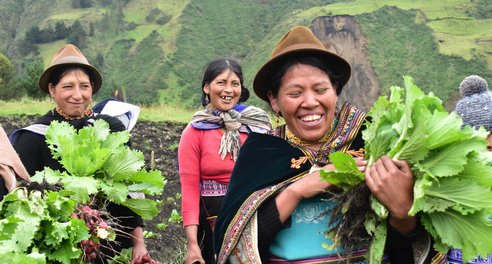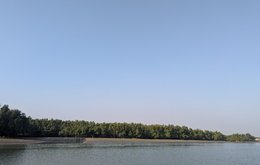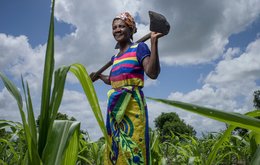A decade after the Paris Agreement, the world is at a critical crossroads on climate action. The climate crisis is accelerating, with heatwaves, wildfires, and storms growing more frequent and severe. For communities - especially women and girls - on the frontlines of the crisis, these impacts often collide with deep-rooted inequalities. This means that those who have contributed least to global emissions often end up paying the heaviest price for global warming.
What is the Paris Agreement?
Ten years ago, nearly 200 countries signed the Paris Agreement at COP21, committing to limit global warming to 1.5°C above pre-industrial levels and strengthen resilience to climate impacts. Significantly, wealthier nations also pledged to support poorer countries with finance for mitigation and adaptation, recognising that responsibility for the crisis is historically unequal.
Why COP30 matters
As leaders, businesses, and civil society gather in Belém, Brazil, for COP30, the world faces a defining moment for climate ambition. Every nation must now present an updated national plan that commits to deep emission cuts in line with the 1.5°C target. Wealthier nations must increase financial provision. Many developed countries, including the UK, are due to announce what their renewed climate finance commitments would be.
Women and girls must be at the centre of this ambition. They are disproportionately affected by climate change yet often excluded from decisions that shape solutions. At the same time, they lead climate action in their communities - driving adaptation, resilience, and advocacy.
Below, we outline CARE’s five key asks for COP30 across mitigation, adaptation, and finance - and highlight how a CARE project in Bangladesh is already leading the way in these areas. The work already being done by local communities demonstrates what is possible, and how the proposed policies could help strengthen and scale these efforts.
CARE’s 5 key asks for COP30
1. A robust Global Goal on Adaptation framework
Put in place a robust Global Goal on Adaptation (GGA) framework that includes clear indicators and a strong means of implementation to ensure adaptation finance is effective, equitable and accessible
The Global Goal on Adaptation was included in the Paris Agreement, with the aim of providing a clear framework and targets for measuring progress on adaptation. Although an overarching framework has been agreed, it still lacks clear targets and indicators, as well as measures to mobilise means of implementation – particularly finance. Despite long-standing commitments, climate finance remains far below what’s needed. The $300 billion agreed annually by 2035 falls short of the $1.3 trillion a year required to meet global needs for climate action. The Baku–Belém Roadmap must set a credible pathway to this higher target, through mechanisms that focus on grants rather than loans.
A recent report by CARE and Oxfam found that for every $5 of loan-based finance received, developing countries repay $7, which deepens debt burdens and leaves frontline communities worse-off.
2. Triple adaptation finance
Triple adaptation finance by 2030 to close the adaptation finance gap and protect vulnerable communities
While mitigation refers to reducing carbon emissions in order to minimise global warming, climate adaptation means preparing for and adjusting to the impacts of climate change that are already underway. In developing countries, adaptation finance needs are 12-14 times as much as current finance flows. At COP30, we need to close the adaptation gap with a post-2025 target that triples adaptation finance for vulnerable communities.
Adaptation finance in action in Bangladesh
In the Sundarbans in Bangladesh, the NABAPALLAB project (Nature-Based Adaptation towards Prosperous and Adept lives and Livelihoods in Bangladesh) shows how adaptation finance can support communities on the frontline of the climate crisis to lead the way on effective, gender responsive adaptation. The Sundarbans are the world’s largest mangrove forest and a natural buffer against climate impacts such as storms and rising sea levels. Mangroves are also among the planet’s most powerful carbon sinks, storing up to ten times more carbon than tropical forests.

NABAPALLAB works with women-led community groups to regenerate mangroves through Assisted Natural Regeneration (ANR) and local nurseries. Along the Gobra-Kopotakkho river, 15 hectares of barren land have been transformed with native mangrove species, which then protect communities from the ever-increasing storm surges which are impacting them. The project also works with communities to excavate canals and ponds in the Sundarbans, creating natural drainage during flooding and capturing water to use for irrigation, which helps boost seasonal farming production.
Community-led adaptation such as this shows what is possible when finance is channelled to communities on the frontlines of the climate crisis, and why it is critical that additional global finance is delivered so that projects like can be scaled up.
3. Adopt an ambitious Gender Action Plan
Adopt an ambitious Gender Action Plan with secured funding to support women-led organisations in climate action
States must agree a new, well-funded and rights-based Gender Action Plan that supports women-led and women’s rights organisations and embeds gender equality across all climate policies. Women’s leadership in agriculture, health, and education is essential to effective and inclusive climate action. Lack of concerted action will reinforce existing inequities and injustice.
Women’s leadership in Bangladesh
The impact of women’s leadership is evident within NABAPALLAB, which supports women and girls to lead and contribute to activities, including inclusion in Project Implementation Committees (PIC) which oversee delivery and monitoring of each project activity. The project takes an intersectional approach to gender considering age, disability and ethnicity as well as adapting activities to ensure they are responsive to the needs of women and other vulnerable groups. For example, by providing lightweight agricultural tools for older and disabled women and making sure training locations are fully accessible, the project benefits from participation from as many community members as possible.
4. Align Nationally Determined Contributions with the 1.5°C Pathway
Nationally Determined Contributions (NDCs), which are each country’s action plan for climate, must be aligned with the goal of keeping warming below 1.5°C.
This means clear milestones for full fossil fuel phaseout, massively investing in renewable energy production led by communities, and reducing deforestation. However, there is an ‘ambition gap’ between what’s been presented in the new round of NDCs, and what is actually needed to keep to the 1.5°C target.
Embracing renewable energy in Bangladesh
It is critical that any transition to low carbon economies takes place while keeping justice and equity at its core, ensuring greener jobs and access to clean energy. For instance, despite the fact that Bangladesh’s global share of emissions is just 0.3%, NABAPALLAB is supporting communities to embrace renewable energy systems. This not only helps lower emissions in line with Bangladesh’s NDC but also supports green livelihoods by providing energy for small enterprises such as shops and sewing businesses. NABAPALLAB is working to stimulate the local renewable energy market, piloting technologies and business models and creating demand from users to sustain the market.
5. Provide fair Loss and Damage Finance
After decades of advocacy, the new Loss and Damage Fund must now deliver on its promise of financial assistance to nations most vulnerable and impacted by the effects of climate change.
This includes Bangladesh, which consistently ranks within the top 10 most vulnerable countries in the world to climate induced disasters and urgently requires support from the Fund to help communities who are living on the frontline.
In 2024, Cyclone Remal affected 4.6 million people across Bangladesh, displaced 800,000, and resulted in 18 deaths. The cyclone also inflicted severe economic damage, wiping out crops worth US$90.7 million, causing infrastructure damage estimated at $600 million and flooding 50,000 fish enclosures. Making the new Fund fully operational, ensuring grant-based finance that is fair, transparent, and accessible for community-led initiatives, is critical for communities bearing the brunt of climate impacts.

COP30 - a turning point?
At COP30 - dubbed the “People’s COP” - CARE International will stand with the global community in a collective effort (“Mutirão”) for climate justice. Ten years on from Paris, COP30 must mark the turning point towards a just, inclusive, and sustainable future for all.
About NABAPALLAB
The NABAPALLAB project (Nature-Based Adaptation towards Prosperous and Adept lives and Livelihoods in Bangladesh) is funded by the UK Foreign Commonwealth and Development Office (FCDO) and delivered by a CARE International led consortium of partners including Center for Natural Resource Studies (CNRS), Cordaid, the Centre for Climate Change and Environmental Research (C3ER)-BRAC University, Dushtha Shasthya Kendra (DSK), Friendship, Humanity & Inclusion (HI), International Development Enterprises (iDE), and Practical Action.



